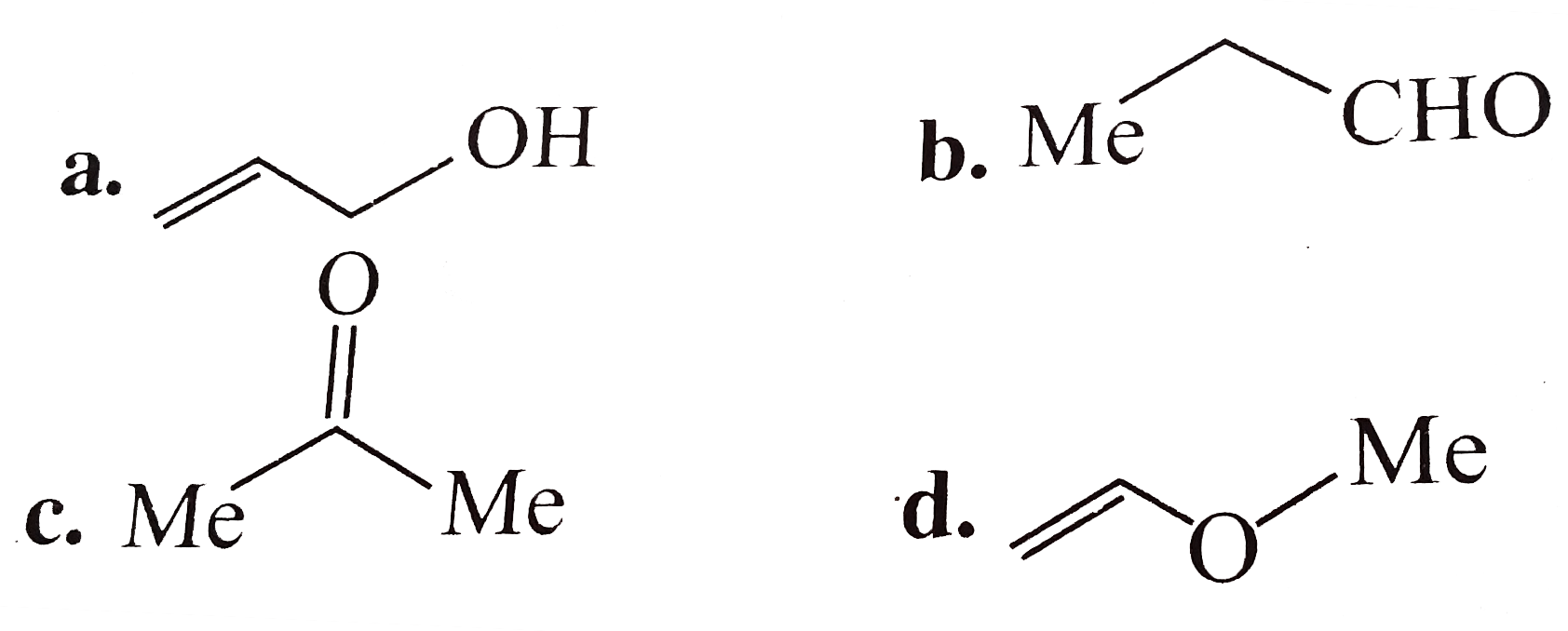An organic compound 'X' having molecular formula C5H10O yield phenylhydrazone and gives negative response to the iodoform test and Tollens test . It produces n-pentane on reduction. 'X' could be
Pentanal
2-pentanone
3-pentanone
n-amyl alcohol
The correct Answer is:C
To solve the problem, let's break down the information given about the organic compound 'X' with the molecular formula C5H10O step by step.
Step 1: Analyze the Molecular Formula
The molecular formula C5H10O indicates that the compound contains 5 carbon atoms, 10 hydrogen atoms, and 1 oxygen atom. This suggests that the compound could be an aldehyde or a ketone, as both types of compounds can have this formula.
Hint: Look for functional groups that can be derived from the molecular formula.
Step 2: Identify the Functional Group
The problem states that compound 'X' yields phenylhydrazone when treated with phenylhydrazine. This indicates that 'X' must contain a carbonyl group (C=O), as only carbonyl compounds can react with phenylhydrazine to form hydrazones.
Hint: Remember that phenylhydrazone formation is characteristic of carbonyl compounds.
Step 3: Consider the Test Results
The compound gives a negative response to the Iodoform test and the Tollens test.
- A negative Tollens test indicates that 'X' is not an aldehyde since aldehydes typically give a positive Tollens test.
- A negative Iodoform test suggests that 'X' does not have a methyl ketone structure (i.e., a carbonyl group bonded to a methyl group).
Hint: Use the test results to eliminate possible structures.
Step 4: Determine the Type of Compound
Since 'X' is confirmed to be a ketone (due to the negative Tollens test) and it does not have a methyl group adjacent to the carbonyl (due to the negative Iodoform test), we can conclude that 'X' must be a ketone that does not have a terminal methyl group.
Hint: Focus on the structural possibilities of ketones with 5 carbon atoms.
Step 5: Identify Possible Ketones
For the formula C5H10O, the possible ketones are:
1. 2-Pentanone (CH3-CO-CH2-CH2-CH3)
2. 3-Pentanone (CH3-CH2-CO-CH2-CH3)
Both of these structures are valid ketones. However, we need to determine which one fits the criteria of not giving a positive Iodoform test.
Hint: Draw the structures of the possible ketones and check for the presence of a methyl group adjacent to the carbonyl.
Step 6: Check Iodoform Test
- 2-Pentanone: This ketone has a methyl group adjacent to the carbonyl (C=O), so it would give a positive Iodoform test.
- 3-Pentanone: This ketone does not have a methyl group adjacent to the carbonyl, so it would give a negative Iodoform test.
Since 'X' gives a negative Iodoform test, it must be 3-Pentanone.
Hint: Confirm the structure of 3-pentanone and ensure it matches all the criteria given in the problem.
Step 7: Conclusion
Based on the analysis, the organic compound 'X' with the molecular formula C5H10O, which yields phenylhydrazone, gives negative responses to both the Iodoform and Tollens tests, and produces n-pentane upon reduction, is 3-Pentanone.
Final Answer: X=3-Pentanone
The molecular formula C5H10O indicates that the compound contains 5 carbon atoms, 10 hydrogen atoms, and 1 oxygen atom. This suggests that the compound could be an aldehyde or a ketone, as both types of compounds can have this formula.
The problem states that compound 'X' yields phenylhydrazone when treated with phenylhydrazine. This indicates that 'X' must contain a carbonyl group (C=O), as only carbonyl compounds can react with phenylhydrazine to form hydrazones.
The compound gives a negative response to the Iodoform test and the Tollens test.
- A negative Tollens test indicates that 'X' is not an aldehyde since aldehydes typically give a positive Tollens test.
- A negative Iodoform test suggests that 'X' does not have a methyl ketone structure (i.e., a carbonyl group bonded to a methyl group).
Since 'X' is confirmed to be a ketone (due to the negative Tollens test) and it does not have a methyl group adjacent to the carbonyl (due to the negative Iodoform test), we can conclude that 'X' must be a ketone that does not have a terminal methyl group.
For the formula C5H10O, the possible ketones are:
1. 2-Pentanone (CH3-CO-CH2-CH2-CH3)
2. 3-Pentanone (CH3-CH2-CO-CH2-CH3)
- 2-Pentanone: This ketone has a methyl group adjacent to the carbonyl (C=O), so it would give a positive Iodoform test.
- 3-Pentanone: This ketone does not have a methyl group adjacent to the carbonyl, so it would give a negative Iodoform test.
Based on the analysis, the organic compound 'X' with the molecular formula C5H10O, which yields phenylhydrazone, gives negative responses to both the Iodoform and Tollens tests, and produces n-pentane upon reduction, is 3-Pentanone.
Similar Questions
Knowledge Check
- Question 1 - Select One
A compound 'A' having the molecular formula C5H12O, on oxidation gives a compound 'B' with molecular formula C5H10O. Compound 'B' gave a 2, 4- dinitrophenylhydrazine derivative but did not answer haloform test or silver mirror test. The structure of compound 'A' is
ACH3−CH2−CH2−CH2−CH2−OHBCH3−CH2−CH2−CH∣OH−CH3CCH3−CH2−CH∣OH−CH2−CH3DCH3−CH2−CH∣CH3−CH2−OH - Question 2 - Select One
An organic compound of molecular formula C3H6O did not give a silver mirror with with Tollens' reagent but give an oxime with hydroxylamine. It may be
ACH2=CH−CH2−OHBCH3COCH3CCH3CH2CHODCH2=CH−OCH3
Compound (X) having molecular formula C6H12Cl2 on hydrolysis gives a ketone. Therefore (X) will be
View SolutionA compound X has a molecular formula of C5H10. Write down the empirical formula of X.
View SolutionA compound (A) with molecular formula C5H10 gives one monochlorination product. Compound (A) is:
View SolutionHow many structural isomeric ketones having molecular formula (C5H10O) give iodoform test?
View SolutionAn organic compound of molecular formula C3H6O did not give a silver mirror with Tollens reagent but gave a positive Brady's test and positive iodoform test. It may be:
 View Solution
View SolutionAn organic compound 'A' having molecular formula C5H10O6 on acetylation forms a compound having molecular weight 334. Number of hydroxy group (-OH) in the compound 'A' is:
View Solution

